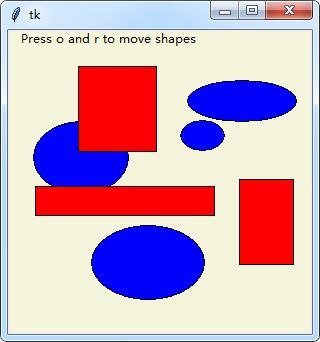溫馨提示×
您好,登錄后才能下訂單哦!
點擊 登錄注冊 即表示同意《億速云用戶服務條款》
您好,登錄后才能下訂單哦!
本文實例講述了Python tkinter事件高級用法。分享給大家供大家參考,具體如下:
先來看看運行效果:

完整實例代碼:
# -*- coding:utf-8-*-
#! python3
from tkinter import *
import threading, time
trace = 0
class CanvasEventsDemo:
def __init__(self, parent=None):
canvas = Canvas(width=300, height=300, bg='beige')
canvas.pack()
canvas.bind('<ButtonPress-1>', self.onStart) # click
canvas.bind('<B1-Motion>', self.onGrow) # and drag
canvas.bind('<Double-1>', self.onClear) # delete all
canvas.bind('<ButtonPress-3>', self.onMove) # move latest
self.canvas = canvas
self.drawn = None
self.kinds = [canvas.create_oval, canvas.create_rectangle]
def onStart(self, event):
self.shape = self.kinds[0]
self.kinds = self.kinds[1:] + self.kinds[:1] # start dragout
self.start = event
self.drawn = None
def onGrow(self, event): # delete and redraw
canvas = event.widget
if self.drawn: canvas.delete(self.drawn)
objectId = self.shape(self.start.x, self.start.y, event.x, event.y)
if trace: print(objectId)
self.drawn = objectId
def onClear(self, event):
event.widget.delete('all') # use tag all
def onMove(self, event):
if self.drawn: # move to click spot
if trace: print(self.drawn)
canvas = event.widget
diffX, diffY = (event.x - self.start.x), (event.y - self.start.y)
canvas.move(self.drawn, diffX, diffY)
self.start = event
class CanvasEventsDemoTags(CanvasEventsDemo):
def __init__(self, parent=None):
CanvasEventsDemo.__init__(self, parent)
self.canvas.create_text(100, 8, text='Press o and r to move shapes')
self.canvas.master.bind('<KeyPress-o>', self.onMoveOvals)
self.canvas.master.bind('<KeyPress-r>', self.onMoveRectangles)
self.kinds = self.create_oval_tagged, self.create_rectangle_tagged
def create_oval_tagged(self, x1, y1, x2, y2):
objectId = self.canvas.create_oval(x1, y1, x2, y2)
self.canvas.itemconfig(objectId, tag='ovals', fill='blue')
return objectId
def create_rectangle_tagged(self, x1, y1, x2, y2):
objectId = self.canvas.create_rectangle(x1, y1, x2, y2)
self.canvas.itemconfig(objectId, tag='rectangles', fill='red')
return objectId
def onMoveOvals(self, event):
print('moving ovals')
self.moveInSquares(tag='ovals') # move all tagged ovals
def onMoveRectangles(self, event):
print('moving rectangles')
self.moveInSquares(tag='rectangles')
def moveInSquares(self, tag): # 5 reps of 4 times per sec
for i in range(5):
for (diffx, diffy) in [(+20, 0), (0, +20), (-20, 0), (0, -20)]:
self.canvas.move(tag, diffx, diffy)
self.canvas.update() # force screen redraw/update
time.sleep(0.25) # pause, but don't block gui
class CanvasEventsDemoThread(CanvasEventsDemoTags):
def moveEm(self, tag):
for i in range(5):
for (diffx, diffy) in [(+20, 0), (0, +20), (-20, 0), (0, -20)]:
self.canvas.move(tag, diffx, diffy)
time.sleep(0.25) # pause this thread only
def moveInSquares(self, tag):
threading.Thread(self.moveEm, (tag,)).start()
if __name__ == '__main__':
CanvasEventsDemoThread()
mainloop()
更多關于Python相關內容可查看本站專題:《Python數學運算技巧總結》、《Python正則表達式用法總結》、《Python數據結構與算法教程》、《Python函數使用技巧總結》、《Python字符串操作技巧匯總》及《Python入門與進階經典教程》
希望本文所述對大家Python程序設計有所幫助。
免責聲明:本站發布的內容(圖片、視頻和文字)以原創、轉載和分享為主,文章觀點不代表本網站立場,如果涉及侵權請聯系站長郵箱:is@yisu.com進行舉報,并提供相關證據,一經查實,將立刻刪除涉嫌侵權內容。